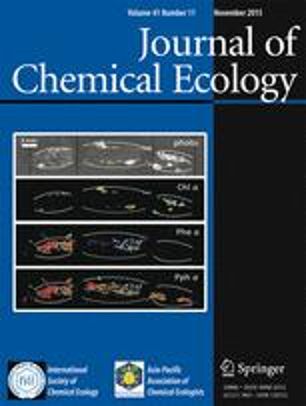Ver ítem
- xmlui.general.dspace_homeCentros e Institutos de InvestigaciónCIRN. Centro de Investigaciones de Recursos NaturalesInstituto de Recursos BiológicosArtículos científicosxmlui.ArtifactBrowser.ItemViewer.trail
- Inicio
- Centros e Institutos de Investigación
- CIRN. Centro de Investigaciones de Recursos Naturales
- Instituto de Recursos Biológicos
- Artículos científicos
- Ver ítem
Both Volatiles and Cuticular Plant Compounds Determine Oviposition of the Willow Sawfly Nematus oligospilus on Leaves of Salix spp. (Salicaceae)
Resumen
Plant volatile organic compounds play a role in selection of host plants by herbivorous insects. Once the insect reaches the plant, contact cues determine host acceptance. Although the willow sawfly Nematus oligospilus (Hymenoptera: Tenthredinidae) can differentiate among willow genotypes, no knowledge is available on the cues used by this insect to seek and accept the host plant. In this study, we recorded behavioral orientation in a Y-tube olfactometer
[ver mas...]
Plant volatile organic compounds play a role in selection of host plants by herbivorous insects. Once the insect reaches the plant, contact cues determine host acceptance. Although the willow sawfly Nematus oligospilus (Hymenoptera: Tenthredinidae) can differentiate among willow genotypes, no knowledge is available on the cues used by this insect to seek and accept the host plant. In this study, we recorded behavioral orientation in a Y-tube olfactometer of willow sawfly females to volatiles of the highly preferred genotype Salix nigra and the non-preferred genotype S. viminalis. The volatiles released by undamaged willows of each genotype were analyzed by coupled gas chromatography-mass spectrometry. Contact cues were evaluated first by oviposition preference bioassays after selective leaf wax removal, and then by studying the micromorphology of abaxial and adaxial leaf surfaces and their chemical composition. Willow sawfly females oriented preferentially to S. nigra volatiles, which contained more than 3 times the amount of volatiles than that collected from S. viminalis. Analysis of volatiles showed significant differences in amounts of (Z) and (E)-β-ocimene, undecane, decanal, and β-caryophyllene. The adaxial leaf surface of S. nigra was less preferred after wax removal, suggesting a role of cuticular waxes for oviposition acceptance. No differences were found among the micromorphology of leaf surfaces between preferred and non-preferred genotypes. The chemical analysis of cuticular waxes showed that the abaxial leaf surface of S. viminalis, which is completely avoided for oviposition, possessed 97 % of alkanes. The accepted leaf surfaces contained a more diverse wax profile including alcohols, acids, and esters. Thus, non-alkane wax compounds might be related to oviposition. In sum, our study suggests that several cues act in concert to provide oviposition cues for the sawfly N. oligospilus: females are attracted to volatiles from a distance, and once alighting on the plant, they seek specific chemical contact cues in order to lay eggs.
[Cerrar]

Autor
Braccini, Celina Laura;
Vega, Andrea Susana;
Coll Araoz, Maria Victoria;
Teal, Peter E.;
Cerrillo, Teresa;
Zavala, Jorge Alberto;
Fernandez, Patricia;
Fuente
Journal of Chemical Ecology 41 (11) : 985–996 (November 2015)
Fecha
2015-11
Editorial
Springer
ISSN
0098-0331
1573-1561
1573-1561
Formato
pdf
Tipo de documento
artículo
Palabras Claves
Derechos de acceso
Restringido
 Excepto donde se diga explicitamente, este item se publica bajo la siguiente descripción: Creative Commons Attribution-NonCommercial-ShareAlike 2.5 Unported (CC BY-NC-SA 2.5)
Excepto donde se diga explicitamente, este item se publica bajo la siguiente descripción: Creative Commons Attribution-NonCommercial-ShareAlike 2.5 Unported (CC BY-NC-SA 2.5)

